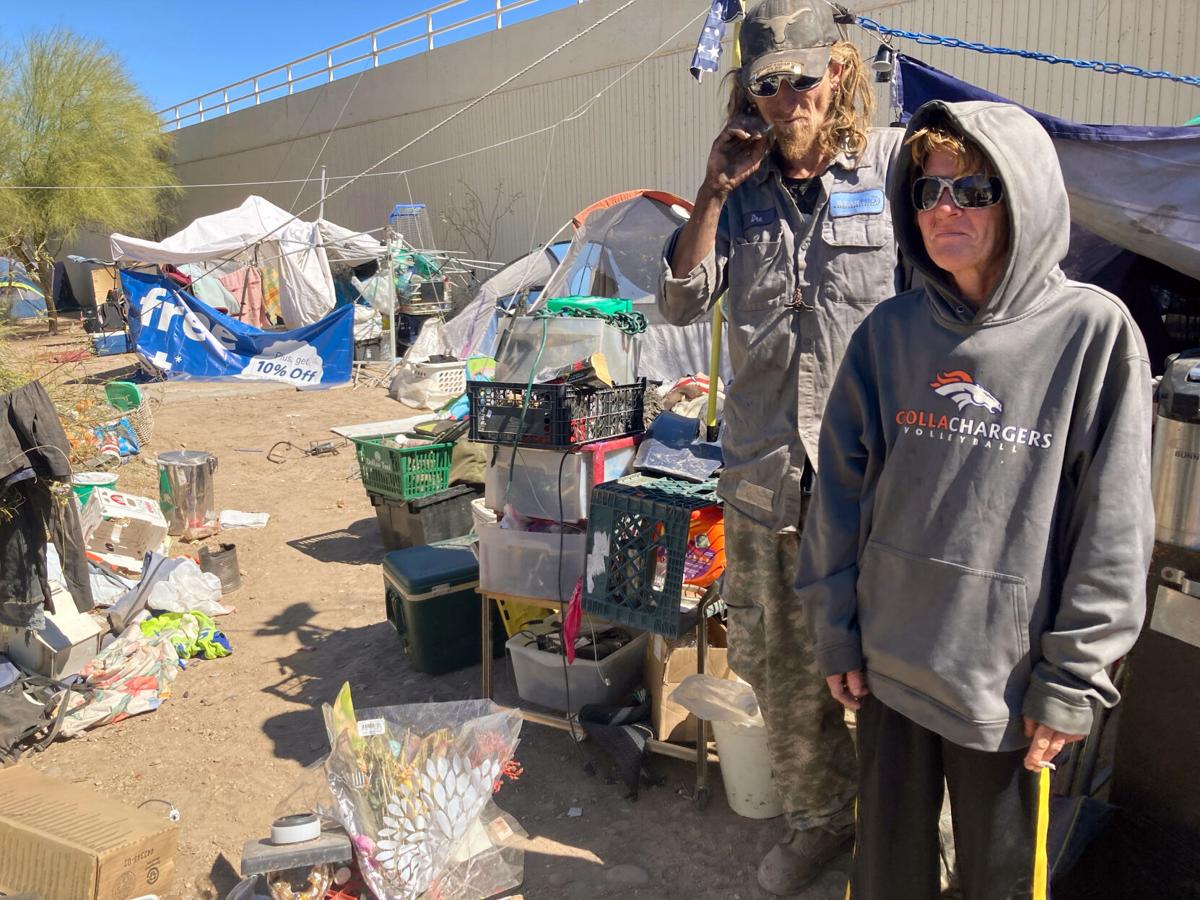You won’t find many people sleeping in tents along East Golf Links Road these days.
After months of complaints and preparation, city officials moved most of the people out of the camp north of Golf Links and east of South Swan Road last week. Till then it was one of the biggest of the city’s proliferating camps.
I walked the stretch Monday night. A lot of garbage remains, and a few campers have stayed or returned, but overall the place is empty compared to the linear village it has been.
The cleanup is a test of the city’s broader approach to homelessness, which is under discussion by city officials now. At a Feb. 8 Tucson City Council meeting, housing director Liz Morales and others outlined ideas for dealing with the city’s proliferating camps. Among the ideas was establishing the city’s own sanctioned camps.
Solving these problems is a long-term proposition. But the Golf Links example shows that incentives are more likely to work than punitive measures, such as those passed by the state senate recently.
What the city offered people camped in that stretch between a wash and Golf Links Road was services and housing. The city has bought three buildings that together will house about 150 people when all ready.
People camping in the area were given about two weeks notice and offered places to stay as well as services. said Sgt. Jack Julsing, the head of the Tucson Police Department’s Homeless Outreach Team.
“For the most part, everybody took the housing,” Julsing said Tuesday.
I met one person Monday who remained. James Oliver, 45, told me that the housing offered wasn’t available to everyone. At the Wildcat Inn, for example, the city’s biggest new property, housing for homeless couples was the priority, he said.
By the time they got to him, what was left was shelter at the Gospel Rescue Mission, he said. He’s stayed, quietly.
“I stay here, but I don’t stay here,” Oliver said. He said officials have told him “Don’t make it obvious, be gone, come back at night.”
The city would need about 2,000 available units just to get every homeless person housed, Morales told the council Feb. 8. That could happen eventually, but it will take years.
In the meantime, Morales and Sarah Launius — the new director of the city’s Community Safety, Health and Wellness Program — proposed setting up city-sanctioned camping areas, safe-parking areas, or “pallet shelter villages” made up of small structures.
A 45-shelter village could house up to 90 people, be delivered in two to three months and would cost the city about $1.45 million, Launius said.
These are not brand-new ideas — they’ve been tried around the country. Even Las Cruces, N.M., has a site called “Camp Hope” that has existed for 10 years. But in Tucson it has been a hard sell, in part because it’s hard to decide where to put the camps or villages.
The state Senate has passed a bill, still to be considered in the House, that would give cities some incentives to establish such sites. SB 1581 would allocate $30 million to Arizona cities to set up camp sites with potable water, secure places to store belongings and other basic amenities.
But there are a few key drawbacks: The money is only available to cities having and enforcing codes that prohibit sleeping in public places. This sort of prohibition has largely been ruled unconstitutional by the 9th U.S. Circuit Court of Appeals.
And it’s just $30 million, one time, for all Arizona cities who participate, plus $20 million for social service agencies in those cities. There’s no ongoing support attached to the bill. When you consider the needs in Phoenix alone, it’s really a small amount of money, especially in a state with a budget surplus well over $1 billion.
“If we have an ordinance in place that makes it illegal to sleep outside, that’s probably a violation of federal law,” said council member Steve Kozachik, a booster of the sanctioned-camp idea. “I wouldn’t support the idea that we’re going to try to track down anyone in an encampment and throw them in jail.”
Most of all, it’s the incentives we need to work on. Tucsonans aren’t going to embrace a highly punitive approach to people living outside.
That’s especially true as rents soar, making housing more precarious for an even greater proportion of our neighbors. So we need to make people want to go to a city-sanctioned camp site or village.
I walked along one of the big remaining camp zones Tuesday morning. It’s bounded by West Congress and West St. Mary’s Road, between the Santa Cruz River and Interstate 10. I counted 26 tents in that stretch, meaning at least that many people sleep there.
Michelle LaLone and William Greenaway III, who are friends and neighbors in that stretch, told me they have been living in that broader area for more than two years, switching spots when city officials tell them this or that place is off limits.
They told me that bathrooms, showers and a secure place to store belongings would be the key attractions to any city-sanctioned camping area. Oliver, back on Golf Links, had told me much the same thing.
“Bathrooms are a bonus,” Greenaway said. “It’s nice to have some common decency.”
Of course, any sanctioned camp will likely run into problems with neighbors, the same sort of neighbors who want unsanctioned camps cleared out.
Making people disappear is not an option. So, with things as they are — unaffordable housing, drug abuse, untreated mental illness — setting up places where people can camp or stay in tiny structures, is one of our best options.
As the Golf Links experience, showed, you’ve got to give people an option and a good reason to choose it.





